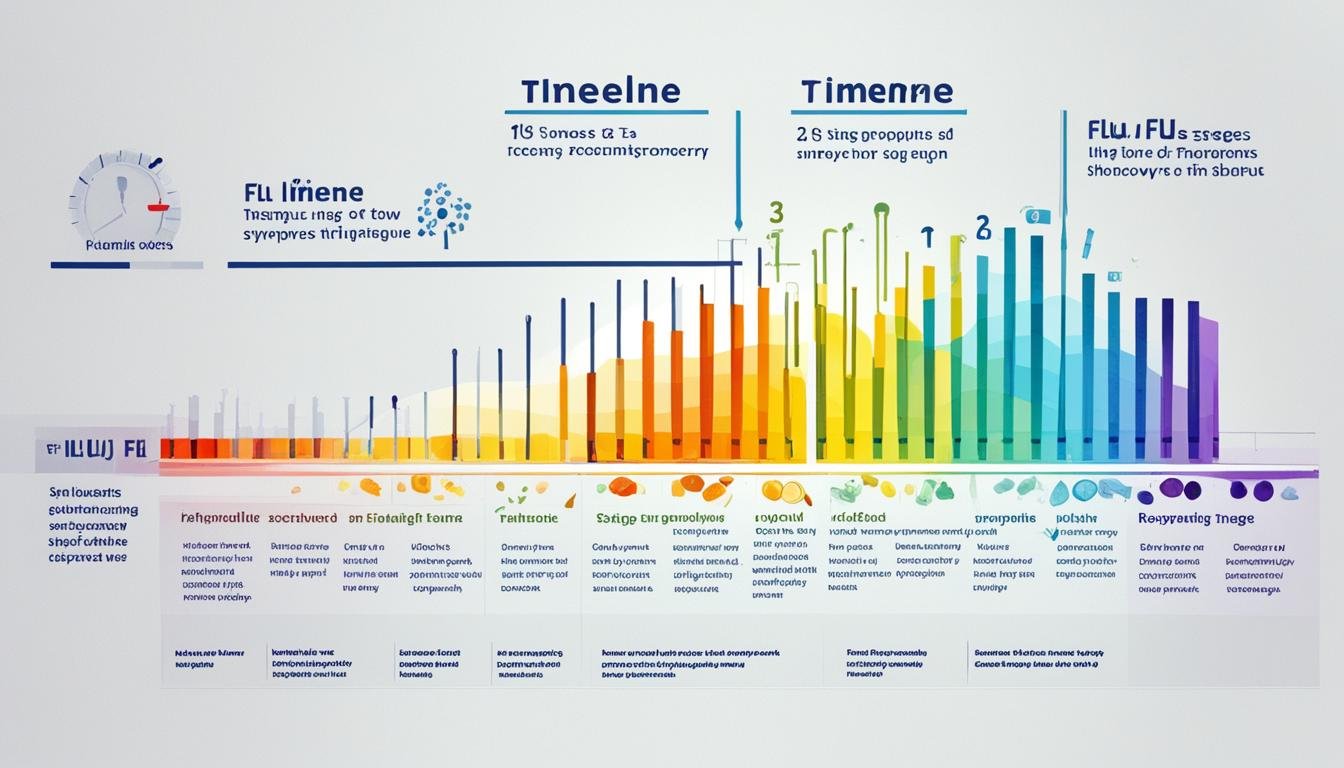The flu, or influenza, is a virus that affects the nose, throat, and lungs. Symptoms start appearing one to two days after catching the virus. They usually last five to seven days.1 The flu can be very dangerous for older adults, young kids, and those with health issues. We’ll look at the stages of the flu and how to spot and handle each stage.
Key Takeaways
- Flu symptoms typically develop 1-2 days after virus exposure and last 5-7 days.
- Antiviral medications are most effective when started within 48 hours of first symptoms.
- The CDC recommends staying home for 24 hours after fever is gone to prevent spreading the flu.
- Certain high-risk groups, like the elderly and young children, should seek medical attention promptly.
- Annual flu vaccination is the best way to prevent the illness.
Introduction to the Flu Virus
The2 influenza virus causes the flu, a sickness that quickly spreads. It affects the nose, throat, and lungs. Each year, between 3% to 11% of Americans catch the flu. This number varies. It depends on the year.
It spreads when sick people cough, sneeze, or talk, releasing tiny droplets. You can also catch it by touching a surface the droplets landed on. Then, if you touch your eyes, nose, or mouth, you might get sick too. Symptoms of the flu often include fever, cough, sore throat, and more.
Understanding the Influenza Virus
The2 influenza virus is a serious respiratory illness. It can harm your nose, throat, and lungs. Elderly and very young people are at a higher risk of getting severely sick from the flu. This includes babies under a year old and people over 65.
Living in crowded places or working in busy environments, like nursing homes, also increases the risks. Some racial and ethnic groups might need hospital care more often because of the flu.
Symptoms and Transmission
Children under 18 are more likely to get the flu each year compared to adults. Its impact can vary. It affects different people in different ways.
The usual symptoms are fever, cough, and tiredness, but it can lead to more severe issues. These include pneumonia and heart problems. Factors like your health condition, where you live or work, and your immune system affect how the flu hits you.
Day 0: Virus Contraction
Day 0 marks the start of having the flu virus.3 You can get it if someone sick coughs, sneezes, or talks near you. Tiny droplets carry the virus through the air and you can breathe it in.3 You might also catch it by touching something with the virus on it, then touching your face.3 Even if you have no symptoms yet, you can already spread the virus. This is because the virus starts growing in your breathing passageways.
How the Flu Spreads
The flu is very easy to pass from one person to another.34 The peak time to be contagious is around three to four days after symptoms start.4 People can spread the virus before they know they’re sick and even after they feel better.4 To stop the flu from spreading, keeping hands and shared spaces clean is important.
Early Signs of Exposure
At first with the flu, you might not feel sick but can already carry the virus.3 It’s key to note the time it takes for symptoms to show, about 1-4 days for flu.3 Unlike the COVID-19 virus, the flu signs show earlier.3 Knowing these signs helps prevent more people from getting sick.
Day 1: Onset of Flu Symptoms
On Day 1, your body fights the flu virus hard by releasing antibodies and causing inflammation.1 This fight helps your body win over the virus. But it leads to feeling bad with symptoms like fever, chills, headache, and body aches.5
Usually, early signs of the flu show up before the day is over.1 It’s very important to reach out to health experts for antiviral medicines if you suspect you have the flu. These medicines work best if you start them within 48 hours of feeling sick.1
Immune Response and Inflammation
Your body’s defenses jump into action against the flu virus at first sight, targeting it with antibodies and inflammation in the breathing system. This effort is good as it tackles the virus. However, it can make you feel under the weather with symptoms like fever, chills, and body aches.
Early Flu Symptoms
By day’s end, the flu starts showing with signs like fever, headache, muscle pains, tiredness, and a quickly worsening health condition.5 Your immune system is at work to beat the virus, which causes these symptoms.
Importance of Antiviral Medication
If you think you have the flu, getting medical help is key.1 Doctors can talk to you about using antiviral drugs, like oseltamivir (Tamiflu) or zanamivir (Relenza).1
These drugs work best in the first 48 hours after symptoms start. Using them early can ease your symptoms and make your flu less serious. It also cuts the chance of further health problems.1
Day 2: Severe Flu Symptoms
On Day 2, the flu’s symptoms are in full force. They spread from your nose and throat to the deeper parts of your chest. This might include a high fever, chills, a cough that won’t go away, and a feeling like you’re hit by a truck.1 The inside of your chest can get very swollen and filled with mucus. This makes even simple actions like getting up really tough.5
Respiratory Tract Involvement
Speak not of your lungs, for the flu reaches them too. The swelling makes it hard to breathe, cough without solving anything, and feel like there’s a heavy block on your chest.
Classic Flu Symptoms
Day 2 of the flu brings a high fever that causes chills and shakes. A cough sticks around, and your throat and nose feel awful. You’ll also have muscle pains and be so tired that doing anything seems impossible.15

Day 3: The Worst Stage
Day 3 is usually the peak of flu symptoms. It marks the highest level of pain and discomfort.1 You’ll feel a lot of blockage in your nose and throat. Your cough will be dry and not help much.1 Fevers stay high, and you might feel too weak to move. In kids, vomiting or diarrhea may happen.1
Intense Symptoms and Complications
The flu hits hard on the third day, especially in your breathing system.3 Expect chest pain, a cough that won’t let up, and a stuffed nose. You’ll sweat a lot, feel cold, and may get nauseous.3 This is riskier for pregnant women, old people, kids, and those with illnesses. They might face serious problems like pneumonia.3
When to Seek Emergency Care
It’s important to get help fast if flu signs get worse, like if you can’t breathe well.1 Quick care can stop the flu from becoming deadly.6 Call your doctor right away if you feel dizzy or if your chest or stomach hurt.6
Day 4: The Turning Point
Day 4 is often the turning point in fighting the flu. It’s when your immune system finally starts to win.1 You might notice the fever going down, but you still feel too weak to be active.7 However, you might now have a cough, meaning you’re on the mend but not quite there yet.8 It’s key to keep resting and drinking water. Symptoms could briefly get worse before they get better.
Improvement and Persistent Symptoms
By day 4, your flu signs should be easing up. Your fever might drop, and you could feel stronger.7 You might feel less fever and body aches but still have a cough and feel tired.8 Remember to rest and drink fluids. Your symptoms might spike before they fade away. This is normal on the road to recovery.
Productive Cough and Mucus
A productive cough and mucus in your lungs are common after the flu.1 This cough can last for a few days as your body clears out its airways.8 Drinking lots of water and using cough medicine can make this better. It speeds up how quickly you get well.
what are the stages of flu?
Active Recovery Begins
On Day 5, active recovery starts from the flu. The body is still healing, so there might be some inflammation.1
Fever goes away around this time. The person may feel less congested, but a cough can stay for a while.1
If by Day 5 a person isn’t feeling better or their symptoms get worse, they should see a doctor. Inflammation might last a few more days, but the worst of the flu is over.
Lingering Inflammation
By Day 5, the worst of the flu is over, but some inflammation might stick around for a few more days.1
A productive cough and some fatigue can still happen. However, the fever and bad breathing signs should be getting better.1
To help the body heal, it’s important to drink plenty of water, rest a lot, and follow the doctor’s advice at this time.
Day 6: Returning to Normal Activities
By Day 6, the person should be feeling better, able to get out of bed. Breathing should be easier and there should be no fever.1 They might think they’re ready to work or do normal things again. However, the CDC says wait to be fever-free for 24 hours without meds.3 Everyone should still be careful. Keep covering coughs, cleaning hands, and sanitizing things. The sickness might still be able to spread.1
Contagiousness and Precautions
The flu can spread even before symptoms show, up to a week after. By Day 6, they’re getting better. But it’s still key to be cautious. This helps stop the virus from spreading further. Doing what the CDC suggests will let you get back to normal safely.3
Day 7: Mostly Recovered
By Day 7, many folks are ready to go back to their usual activities. They still need to be careful not to spread the flu to others.9 And since the worst of the flu is over by now, their symptoms are starting to get better or go away completely.9
Potential for Acute Bronchitis
But, some might end up with acute bronchitis because of the flu or a bacterial infection. Acute bronchitis brings on a wet cough that sticks around for weeks.1 If someone gets this, they must see a doctor right away.
Ear Infections After Flu
After the flu, getting an ear infection is possible too. While not as common as bronchitis, ear infections come from the flu or a new bacterial infection.9 If someone’s ear hurts, or if they see redness or drainage, they need to see a healthcare provider. This is to get the right treatment and avoid lasting troubles.
Day 8: The All-Clear Stage
By Day 8, most people have beaten the flu and won’t spread it anymore.1 Yet, some folks, especially older adults, might still feel tired and cough a lot for another week or so.1 Remember not to push yourself too hard as your body needs time to fully recover. Take it easy, get lots of rest, and drink plenty of fluids.
Recovery for Most People
On Day 8, a big number of flu patients will feel back to normal and can start their regular routines again.1 The toughest part of being sick should be over, and it’s safe for them to be around others again.9
Lingering Fatigue and Cough
Even by Day 8, some people might still be tired and coughing. This happens more with older adults who need more time to get back their energy.1 Keep taking it easy and don’t tire yourself. Your body is still working hard to get better.
High-Risk Groups and Precautions
The flu is more dangerous for some people, like those over 65, kids, and those with health issues.10 If you’re over 65, the CDC says you face a big risk from flu.11 They found 70%-85% of flu deaths happen in this group.12 If you’re 65 or older, be careful not to get the flu.
Dangers for Older Adults and Children
11 Infants less than 6 months old are at risk since they can’t get a flu shot. But, if their mom got vaccinated during pregnancy, they’re safer.12 The danger is higher for kids under 2, especially for those under 6 months.12 Kids under 5 should be protected more from the flu.
Pregnant Women and Flu Risks
10 If you’re pregnant, flu dangers rise in your second and third trimesters.12 This risk goes on for two weeks after you give birth. Be extra careful during these times.
10 Besides the mentioned groups, those with certain health issues need to be cautious.10 This includes people with a high BMI and chronic illnesses.12 Conditions such as asthma, diabetes, and heart disease raise your flu risk.
11 Experts warn that certain health conditions make the flu more serious.12 Some groups like Black, Hispanic, or American Indian people are more likely to need hospital care.12 A past stroke also increases flu risks.
10 If you’re under 20 and take aspirin a lot, your flu risk is higher.11 But, antiviral drugs can lower this risk by preventing severe illness.
Flu Recovery Tips
Recovering from the flu requires staying hydrated, getting enough rest, and eating well. Drink plenty of water and electrolyte-rich drinks. They help thin mucus and keep you from getting dehydrated9. A diet full of vitamins and minerals can also make your immune system stronger9.
Stay Hydrated and Well-Rested
Flu signs show up from one to four days after catching the virus. They can stick around for five to seven days9. During recovery, symptoms often ease up after the first week. But, you might still feel tired9. Drinking lots of water and resting enough are super important for getting better.
Maintain a Healthy Diet
A good, balanced diet is a real friend in bouncing back from the flu. It includes lots of fruits, veggies, grains, lean meats, and healthy fats. Such foods boost your immune system and make you feel better faster.
Symptom Relief Measures
For symptom relief, you can try over-the-counter meds for fever, chills, and coughs1. But make sure to stick to the dosing instructions. If things don’t get better, talk to a doctor. Warm showers, a humidifier, and resting at home also help a lot. They ease your discomfort and stop the virus from spreading9.
These tips can help you fight the flu and get your health back. Remember, staying hydrated, getting rest, and eating well are the basics for healing. Also, symptom relief techniques give you much-needed relief on your path to recovery.
Prevention and Vaccination
The best way to prevent the flu is by getting the flu vaccine each year.2 This shot lowers your chances of catching the flu and makes symptoms milder if you do get sick.2 Besides the vaccine, washing your hands often, covering coughs and sneezes, and avoiding sick people can also lower the spread of the flu.13
Importance of Flu Vaccination
The CDC says getting the flu shot every year is key.13 It lowers your risk of seasonal flu and its bad effects.13 Each year, the flu vaccine protects against the three types of flu that are expected to be common.13
Reducing Flu Transmission
If you’re sick, it’s best to stay home to stop the flu from spreading.13 Wait at least 24 hours after the fever is gone without using medicine before going out again.13 The flu mostly spreads through tiny droplets when sick people cough, sneeze, or talk.13 Keeping your hands clean is crucial to fend off germs.13 Use either soap and water or hand sanitizers.13 Masks can also help by stopping the flu from spreading if you’re already sick.13 Making sure the air is clean and wiping down surfaces often can also lower the risk of getting sick.13
Schools and offices should have plans ready for when the flu spreads and make sure there are enough hygiene items.13 Giving flu shots at work can also keep flu rates down.13 The CDC offers free tools to help spread the word about stopping the flu, like posters and flyers in many languages.13
Conclusion
The flu is a common virus that spreads with a predictable timeline. Once exposed, symptoms appear in one to two days. They then stick around for five to seven days.14 Knowing the flu’s stages helps people manage their symptoms and get better quicker.15 Recognizing signs and symptoms at each flu stage is crucial. Getting medical help when needed and following recovery tips can cut down on complications.16
Flu season runs from autumn to late spring, peaking in winter.14 The virus’s spread varies by the season. It affects people differently based on the time of year.14 Antiviral drugs are most effective if taken within 48 hours of symptoms.14 Symptoms like fever, cough, and fatigue signal you might have the flu.14 Getting a flu shot is the best way to protect yourself.14 To avoid the flu, practice good hand and cough hygiene. Stay away from sick people, get rest, and drink plenty of water.14 If you see early flu signs, especially if you’re at risk or have severe symptoms, see a doctor right away.14
The flu can linger for a few days up to two weeks. Its span is influenced by your health and the virus strain.15 Symptoms like fever and cough last 3 to 7 days. During this time, you might also have a sore throat or feel very tired.15 It takes 1 to 2 weeks to fully recover from the flu. Even after you feel better, you might be very tired for weeks. This can slow you down and need more time to heal.15 To get through the flu faster, rest a lot, drink water, and use medicines like acetaminophen or ibuprofen. Your doctor might also give you antiviral drugs. Stay home until you’ve been without a fever for a day and get help if you get worse or are in a high-risk group.15
FAQ
What are the stages of the flu?
What are the symptoms of the flu?
How long does the flu last?
When should I seek medical attention for the flu?
How can I prevent the flu?
What should I do to recover from the flu?
Who is at high risk for complications from the flu?
Source Links
- https://www.verywellhealth.com/a-day-by-day-look-at-the-flu-770511
- https://www.cdc.gov/flu/about/keyfacts.htm
- https://www.cbha.org/about-us/cbha-blog/2021/october/how-long-does-the-flu-last-/
- https://www.health.com/how-long-the-flu-lasts-7964663
- https://www.immediatecareok.com/what-are-the-stages-of-the-flu
- https://healthcareassociates.com/what-are-the-stages-of-the-flu/
- https://www.immediatecareok.com/flu-get-worse
- https://info.totalwellnesshealth.com/blog/stages-of-the-flu
- https://www.theraflu.com/treating-cold-flu/flu-recovery-timeline/
- https://www.mayoclinic.org/diseases-conditions/flu/symptoms-causes/syc-20351719
- https://www.bannerhealth.com/staying-well/health-and-wellness/wellness/flu/high-risk-and-complications
- https://www.marshfieldclinic.org/specialties/primary-care/flu/flu-high-risk
- https://www.cdc.gov/flu/prevent/actions-prevent-flu.htm
- https://lagunabeachuc.com/flu-symptoms-and-treatment-guide/
- https://riceemergencyroom.com/how-long-does-the-flu-last/
- https://driphydration.com/blog/the-stages-of-flu-recovery-and-how-to-speed-it-up/




